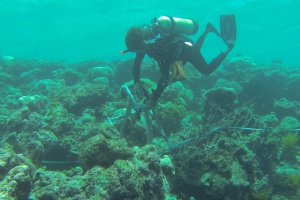SIF keeps a close eye on ‘Black Disease’ in coral reefs of Aldabra
Conservation |Author: Sharon Meriton-Jean and Hajira Amla | January 25, 2015, Sunday @ 11:23| 125852 views
A coral on the Aldabra reef infected with T. hoshinota. The black sponge can be seen to the bottom left of the coral (Seychelles Islands Foundation) Photo license: All Rights Reserved
(Seychelles News Agency) - Coral reefs are considered as the most diverse and valuable underwater ecosystems in existence. They support a variety of marine life that in turn contributes to feeding most of the world’s population as well as providing a means of protection against wave action and land erosion.
Although these living organisms have existed in the world’s oceans for millions of years, they are fragile and constantly under threat. In modern times, the greatest source of these threats are man-made, such as global warming, over-fishing and coastal developments, but often, threats come from other organisms and events in nature.
In the Seychelles, a 115-island archipelago spread widely over the western Indian Ocean, lies one of its most prized and pristine places – the Aldabra atoll. But in this untouched and wild place, where thousands of Aldabra giant tortoises roam free, the coral reefs are under threat from what scientists have dubbed the ‘Black Disease’.
The disease is caused by an unusual increase in the growth of a sponge called Terpios hoshinota, which engulfs huge areas of corals, causing a black crust to cover the affected area.
In their most recent newsletter, the Seychelles Island Foundation (SIF), a public trust which manages the World Heritage Site, says high densities of the sponge were observed in 2012, during a diving exercise on the outer reef of the atoll of the World Heritage Site.
“This caused significant concern as this sponge has been responsible for massive and rapid coral mortality in other parts of the world,” states SIF’s newsletter.
Outbreaks of Black Disease have been recorded in several countries in the past, including the largest coral reef in the world, the Great Barrier Reef of Australia, the largest reef island of the Xisha Islands in the South China Sea, and several islands of the Pacific such as Guam Island.
 |
| SIF researchers stationed on the Aldabra atoll have undertaken a monitoring programme to assess the progression of a coral-killing black-coloured sea sponge (Seychelles Islands Foundation) Photo license: All Rights Reserved |
In spite of several publications and research, it is still unclear how corals responds to such threats and how the sponge is able to overgrow the coral surfaces, reducing their survival and affecting their physical and biological structures.
An invasive mystery
‘Once the sponge has colonized an area of the reef it can last for over a decade, dominating the reef bottom and preventing the recruitment of juvenile corals,’ states the Seychelles Islands Foundation which has been managing Aldabra since early 1980’s.
Other types of sea sponges are natural space and light competitors with corals but they are not considered as threats to these ecosystems.
What causes the black sponges to appear and suddenly increase in numbers remains a mystery although factors such as over-fishing and pollution are often cited.
But Aldabra, the most south-westerly group of islands in the Seychelles, remains almost out of reach and untouched by humans and it is therefore unclear how this sudden surge of Terpios hoshinota could have occurred.
According to SIF, such an outbreak of a ‘potential invasive species’ needs to be studied further as it could have disastrous effect on the reefs around the atoll resulting in large scale coral mortality and rapid degradation of coral communities as has been the case in other affected areas around the world.
In response to the situation, SIF recently launched a monitoring programme at depths of between 5 and 15 metres around the atoll in order to evaluate the distribution of Terpios hoshinota, the extent of the threat towards coral communities and the rate at which it is spreading.
Ten years after the El Niño phenomenon which resulted in the loss of over 80 percent of coral reefs in the Seychelles archipelago and the recent appearance of crown-of-thorns starfish (COTS), the Black Disease could be the latest in a growing list of threats to coral reefs in the Indian Ocean islands if it spreads further.
Back
